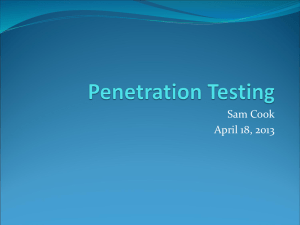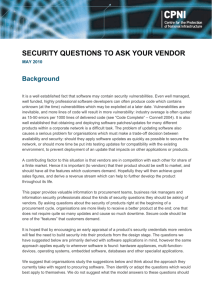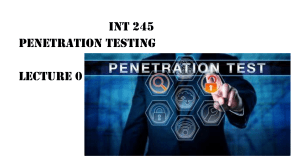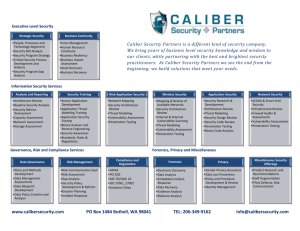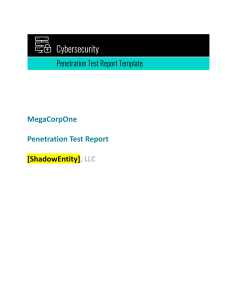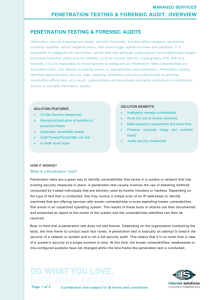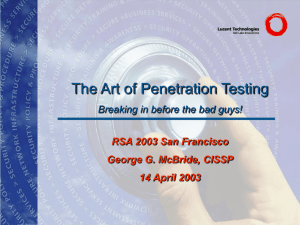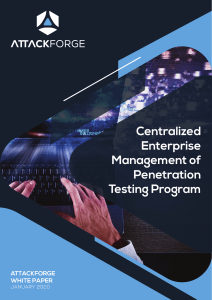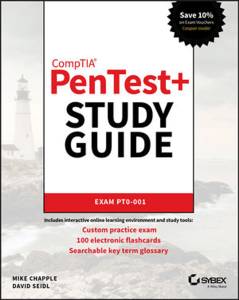Demystifying Penetration Testing for the Enterprise
advertisement
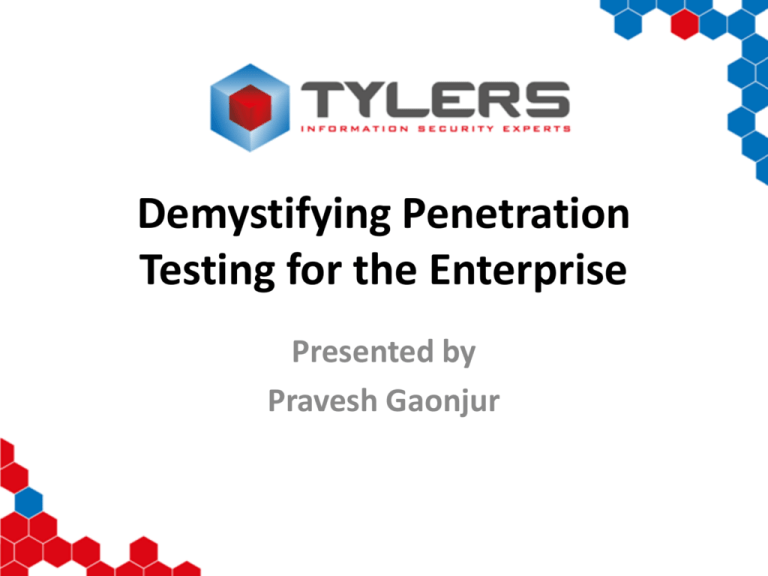
Demystifying Penetration Testing for the Enterprise Presented by Pravesh Gaonjur Pravesh Gaonjur Founder and Executive Director of TYLERS Information Security Consultant Certified Ethical Hacker (CEHv8Beta) Certified ISO27001 Lead Auditor Certified Information Security Manager (CISM) CISM Director at ISACA Mauritius Chapter Part Time Academic at UTM & CDAC Publisher of IEEE papers in Information Security AGENDA What is a Penetration Test Overview of how it works Defining the Pentest Scope Types of Penetration Tests Difference between Penetration Test and Vulnerability Assessment What should the final report contain? Tools What is a Penetration Test Penetration test is an evaluation method to asses computers, systems or networks vulnerabilities and exploit them in order to measure the impact of the flaws to the system under testing Know ‘the enemy’ before identifying the ‘evil’ Think like ‘the evil’ Overview of how it works 1. Planning and Preparation 2. Information Gathering and Analysis 3. Vulnerability Detection 4. Penetration Attempt 5. Analysis and Reporting 1. Planning and Preparation Defining Pentest Scope Non-Destructive Test Destructive Test Types of Environment Wireless DMZ Dial-in etc.. Types of Pentest Black Box Approach Pen tester has no previous knowledge of the remote network Only the company name or the IP address is known Simulation of a real world hacking by a hacker Types of Pentest White Box Approach Pen tester provided with significant knowledge of the remote network Type of network devices (i.e. Cisco gear, TCP/IP), WebServer details (i.e., Apache/*nix or Apache/Win2k), Grey Box Approach Partial knowledge of the network 2. Information Gathering and Analysis Information Gathering This is the first step for any remote host Penetration Testing. Expected Results: Zone Transfer Information Domain Registration Information Email IDs IP Addresses Range Footprinting/Fingerprinting In this step, information like WebServer and OS type running on remote host are gathered to further precise the attack. Expected Results: Remote server OS type Remote server web-server type Applications running on remote server Network Surveying/Mapping A network survey serves often as an introduction to the systems to be tested. It is best defined as a combination of data collection, information gathering, and policy control. Expected Results: Firewall / Routers / IDS Discovery Possible Local Network / Subnet Discovery IP Addresses Range Network Topology Mapping ISP information Port Scanning and Services Identification Port scanning is the invasive probing of system ports on the transport and network level. Expected Results: Open, closed or filtered ports Services Identification Evading Firewall rules In this phase, firewall evasion techniques are used to bypass firewall rules. This can further help in port scanning, remote host detection and remote network discovery. Expected Results: Mapping of firewall configuration rules Partial Access to devices behind the firewall 3. Vulnerability Detection Vulnerability Scanning Identifying, understanding, and verifying the weaknesses, misconfigurations and vulnerabilities associated with remote host. Expected Results: List of vulnerabilities associated with each remote services List of possible denial of service vulnerabilities Possible misconfiguration on the remote server 4. Penetration Attempt Exploiting Vulnerabilities This is the most important phase of penetration testing. Expected Results: Gaining Access to the system Retrieving hidden information Domain Hijacking Spamming Mail Servers Access to restricted / confidential information Control over web configuration Can also leads to gaining access over other servers Brute Force/Password Cracking Password cracking is the process of validating password strength through brute force attempts. Expected Results: List of user login IDs or passwords List of authentication PINs or Password Denial of Service (DoS) Denial of Service (DoS) is a situation where the applications or services running over the remote system stops functioning and prevents authenticated network users or devices to access it. Expected Results: Disruption of Services List of other possible DoS Privilege Escalation It is the final stage of the remote host hacking where the attacker gains complete control over the remote system. Expected Results: Gain administrator / Super User rights Gain privilege to retrieve or modify confidential data Gain control over server configuration Gain Control over other servers attached to it 5. Analysis and Reporting Contents of the Report Executive Summary Briefing on the type of test performed A pie graph displaying the vulnerabilities in terms of percentage of high, low & medium Risk Matrix Quantifying the vulnerabilities and showing the high, low & medium in a tabular format Giving a brief of the vulnerabilities found Proof of Concepts (POC) Giving a detail description with the screenshots and logs of the vulnerabilities found and exploited. Contents of the Report Remedies and Workarounds Providing customized remedies and workarounds for the vulnerabilities found Best practices Suggesting best practices for the configurations for the device or services Final Summary Must contain a brief on the overall vulnerability factor found for the remote device Difference between Pentest and VA Vulnerability Assessment Only scan for Vulnerabilities Using Automated tools Penetration Test Scan for Vulnerabilities Automated and manual Analysis Exploits Technical and Non-Technical Attacks Some tools for Pentesting Automated Exploiting Tools Metasploit Framework, Core Impact, Canvas Password Cracking / Brute Forcing Tools John the ripper, L0phtcrack, MD5 Crack, SQL Bruteforce, CISCO Password decryptor, SolarWinds Network Password Decryptor, Cain & Abel, THC-Hydra, BRUTUS etc. Sniffers Ethereal, Ettercap, Dsniff, Hunt Some tools for Pentesting Denial of Service (DoS) Tools HPING & openly available DoS exploits (Zero-Day and Others) Exploits Used Both customized and publicly available exploits (ZeroDays and Others) and sometimes exploits are coded depending upon the requirements Tools Kit Knoppix-STD, PHLAK, Auditor Security Collection etc. Questions? Thank you for your attention!

